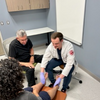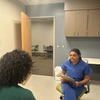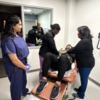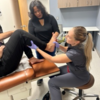Simulated Patients
Simulated Patients represent an advanced form of the standardized patient method, tailored to meet students' learning needs. Unlike Standardized Patients, who are primarily used for assessment, Simulated Patients focus on addressing individual student needs in a learning capacity. During one-on-one clinical simulation sessions, students practice interviewing, examining, assessing, and diagnosing patients in controlled settings. Simulated Patients provide feedback on students' manner, professionalism, and interpersonal skills, relating these to the core competencies of information gathering and physical examination. Although still overseen by Physician Instructors, SPs are trained to deliver physicians’ insights and expertise consistently to students. While generally not medically trained, Simulated Patients benefit from these clinician instructors and help students understand the capabilities and limitations they will encounter in real patients.
Through these methods, TUSPM’s Standardized Patient Program provides a comprehensive and nurturing learning environment, preparing students for their future careers as clinical practitioners.




